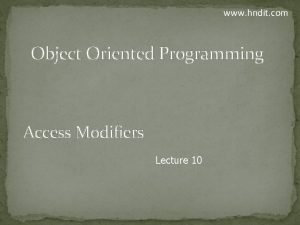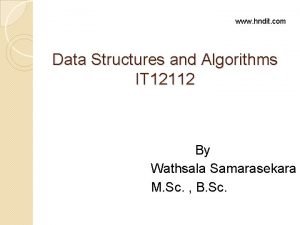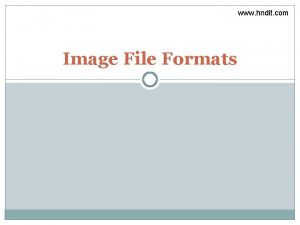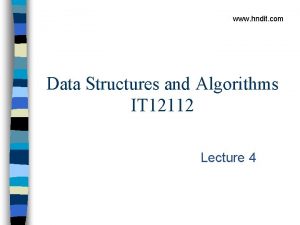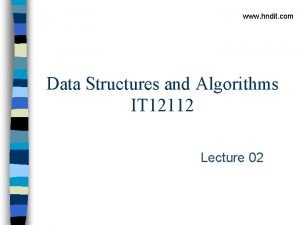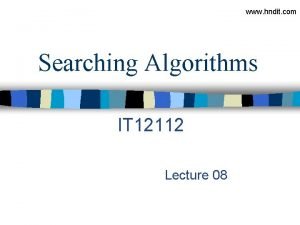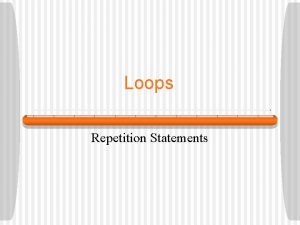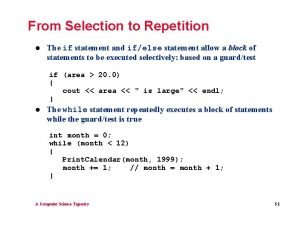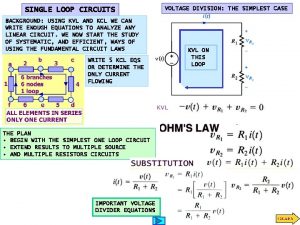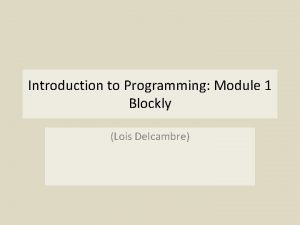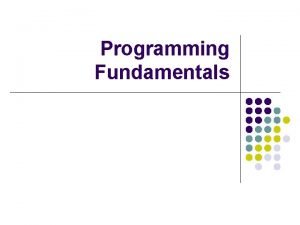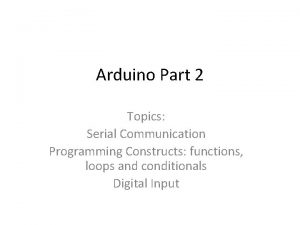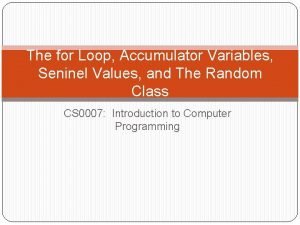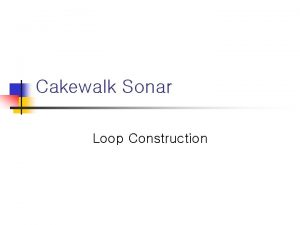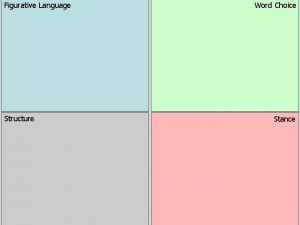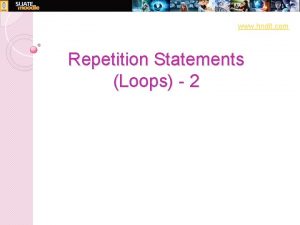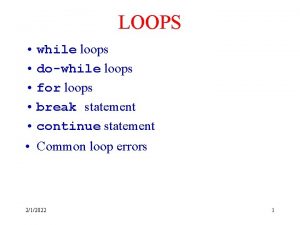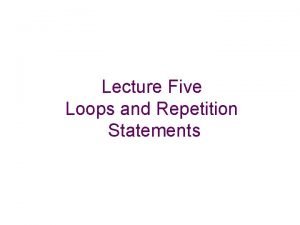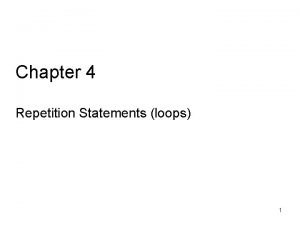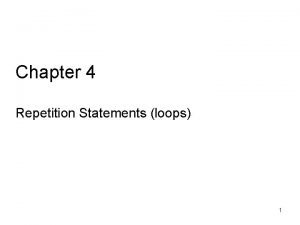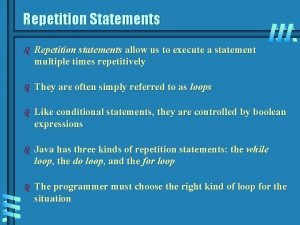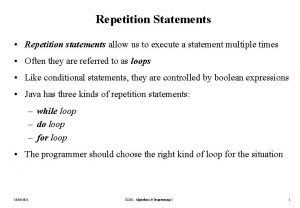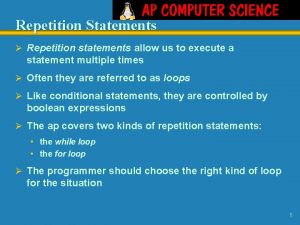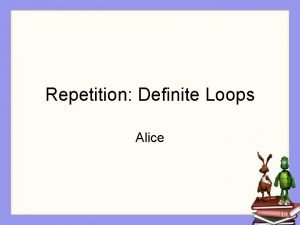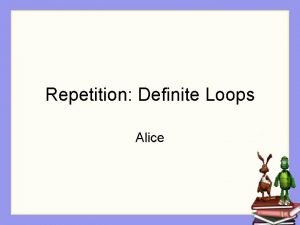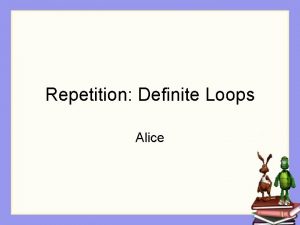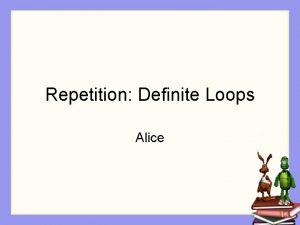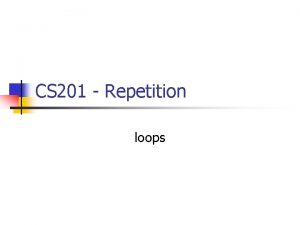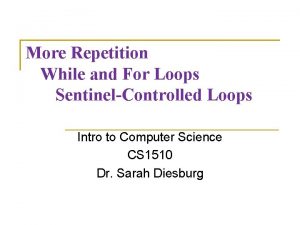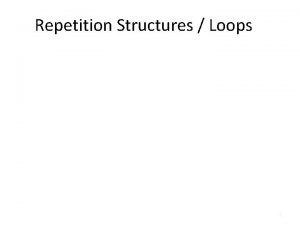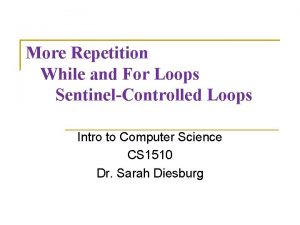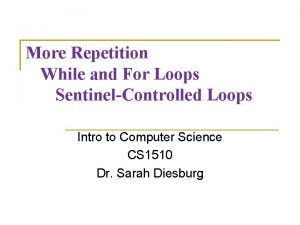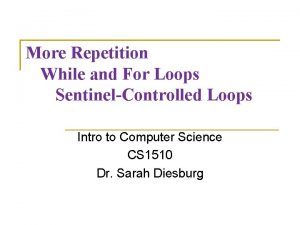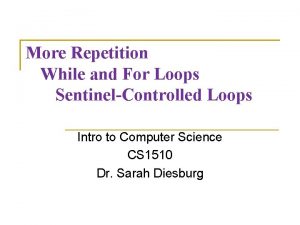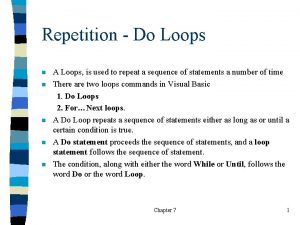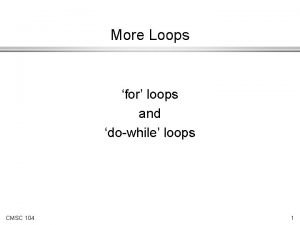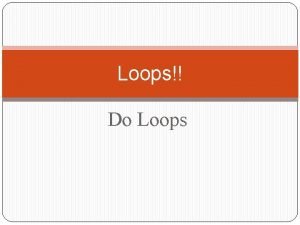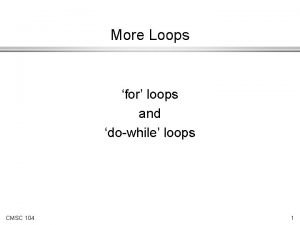www hndit com Repetition Statements Loops www hndit

























- Slides: 25

www. hndit. com Repetition Statements (Loops)

www. hndit. com Introduction to Loops �We all know that much of the work a computer does is repeated many times. �When a program repeats a group of statements a given number of items, the repetition is accomplished using a loop. �Loops are iteration structures. �Each loop or pass through a group of statements is called an iteration. 2

www. hndit. com Repetition Statements �Our third control structure: iteration or repetition (completes our three control structures: sequence, selection, iteration) �Two main categories of repetition: ◦ definite loop �repeats a predetermined number of times ◦ indefinite loop �repeats a number of times that has not been predetermined. 3

www. hndit. com Repetition Forms ◦ Three loop types: �for<a definite number of times> <do action> �while<condition is true> <do action> �do<action> while <condition is true> ◦ Three basic constructs �A variable is assigned some value. �The value of the variable changes at some point in the loop. �The loop repeats until the variable reaches a predetermined value, the program then executes the next statement after the loop. 4

www. hndit. com Pretest Loops �Pretest Loop (Entrance Controlled Loops) ◦ a loop where the control condition (Boolean expression) is tested BEFORE the loop. ◦ If the condition is true, the loop is executed. ◦ If the condition is false the loop is not executed ◦ Therefore, it is possible that these loops may not be executed at all (when the condition is False) ◦ There are two pretest loops �for loop �while loop 5

Post Test Loops �Post www. hndit. com Test Loops (exit-controlled loop) ◦ a loop where the control condition (Boolean expression) is tested AFTER the loop has been executed. ◦ If the condition is true, the loop is executed again. ◦ If the condition is false the loop is not executed again. ◦ Therefore, this type of loop will always be executed at least once. ◦ There is one post test loop: do…while 6

Fixed repetition loops �Fixed www. hndit. com repetition loop ◦ a loop used when you know in advance how many repetitions need to be executed, or when you ask the user how many repetitions are needed. ◦ also known as a definite loop: �The programmer knows, or the user chooses the definite number of repetitions necessary to solve the problem. ◦ the “for” loop is: �a fixed repetition loop �and a pretest loop 7

Variable Condition Loopswww. hndit. com �Variable Condition Loops ◦ needed to solve problems where the conditions change within the body of the loop. ◦ Also called indefinite loops: �the loop repeats an indefinite number of iterations until some condition is met, or while some condition is met. �While and do…while loops are variable condition loops. 8

www. hndit. com The for Loop �The for loop repeats one or more statements a specified number of times. �Like an if statement, the for loop uses parentheses. �In the parentheses are three items called parameters, which are needed to make a for loop work. �Each parameter in a for loop is an expression. 9

www. hndit. com The for Loop �General form: for(<initialization expression>; <termination or control conditon>; <update or step expression> ) <statement> for(counter = 1; counter <= 10; counter++)//Loop Heading cout<< counter << endl; //Loop body 10

Syntax and Semantics of the for Loop www. hndit. com for (<initializer>; <termination>; <update>) <statement> Loop body Loop header false initializer termination true statement update 11

www. hndit. com The for Loop Internal Logic �The control variable is assigned an initial value in the initialization expression �The termination condition is evaluated �If termination condition is true ◦ the body of the loop is executed and the update expression is evaluated �If the termination condition is false ◦ program control is transferred to the first statement following the loop. 12

www. hndit. com Code List # include <iostream. h> void main( ) { int counter ; // counter variable for (counter = 1; counter <= 3; counter ++) cout << counter << endl; } 13

www. hndit. com Counting Backward and Other Tricks �A counter variable can also count backward by having the step expression decrement the value rather than increment it. �The program in Code List counts backward from 10 to 1. ◦ The counter is initialized to 10. ◦ With each iteration, the decrement operator subtracts 1 from the counter. 14

www. hndit. com Code List #include <iostream. h> void main ( ) { int counter ; // counter variable for(counter = 10; counter >= 0; counter --) cout << counter << end 1; cout << “”End of loop. n”; } 15

www. hndit. com Code List #include <iostream. h> void main ( ) { int counter ; // counter variable for (counter = 1; counter <= 100; counter = counter + counter ) cout << counter << end 1; } 16

Scope of Loop Control Variable www. hndit. com �The loop control variable must be declared before it is used. ◦ The rules for the scope of the variable apply here. �If the variable is only going to be used as a loop counter, and for nothing else… ◦ You can limit it’s scope by declaring it when it is initialized in the loop for(int counter = 1; counter <=10; ++ counter ) cout<< counter <<endl; // counter is only // referenced in the loop 17

For Loops �For www. hndit. com loops can count down (decrement) for(int counter=20; counter>=15; --counter) cout<< counter << endl; �For loops can count by factors other than one for(int counter=2; counter<=10; counter=counter+2) cout<< counter << endl; 18

www. hndit. com For Statement Flexibility �The for statement gives you a lot of flexibility. �As you have already seen, the step expression can increment, decrement, or count in other ways. 19

www. hndit. com �Some more examples of for statements are shown in Table 20

www. hndit. com Accumulator ◦ An accumulator is a variable used to keep a running total or sum of successive values of another variable �i. e. sum = sum + grade; �you should initialize the value of the accumulator before the loop: sum = 0; �the accumulator statement occurs in the body of the loop //lcv means loop control variable sum=0; for(lcv = 1; lcv <= 100; ++lcv) sum = sum + lcv; 21

www. hndit. com Using a Statement Block in a for Loop � If you need to include more than one statement in the loop, place all the statements that are to be part of the loop inside braces {curly brackets}. � The statements in the braces will be repeated each time the loop iterates. � The statements that follow the braces are not part of the loop. � In Code List an output statement has been added inside the loop of the backward. cpp program. � The phrase inside loop will appear with each iteration of the loop. 22

www. hndit. com Code-List #include <iostream. h> voidmain ( ) { int I; for( i = 10; i >= 0; i--) { cout << i << endl; cout << “Inside Loopn”; } cout << “End of loop. n”; } 23

www. hndit. com Errors with for Loops �Do NOT place a ; (semicolon) directly after the command for in a for loop: �Don’t do this for example: for(int i = 1; i <= 10; i ++) ; //Don’t do this! cout << i << end 1; �This will prevent any lines of code within the loop from being repeated or iterated. �This will result in a logic error, the compiler will NOT tell you that there is a syntax error. 24

Q&A www. hndit. com
 Bài thơ mẹ đi làm từ sáng sớm
Bài thơ mẹ đi làm từ sáng sớm Cơm
Cơm Hndit syllabus
Hndit syllabus Hndit
Hndit Hndit
Hndit Hndit syllabus
Hndit syllabus Data structure
Data structure Hndit application 2020
Hndit application 2020 Hndir.com
Hndir.com Hndit
Hndit Hndit
Hndit Hndit.com
Hndit.com Examples of binary fusion
Examples of binary fusion Loaded words examples in advertising
Loaded words examples in advertising Repetition statements in java
Repetition statements in java Selection with repetition
Selection with repetition Kvl multiple loops
Kvl multiple loops Programming puzzle
Programming puzzle What is loop
What is loop Its platinum loops shrink to a wedding-ring
Its platinum loops shrink to a wedding-ring Arduino conditionals
Arduino conditionals Seninel
Seninel Small basic turtle
Small basic turtle Cakewalk loop construction
Cakewalk loop construction Its platinum loops shrink to a wedding-ring
Its platinum loops shrink to a wedding-ring Sun means
Sun means



